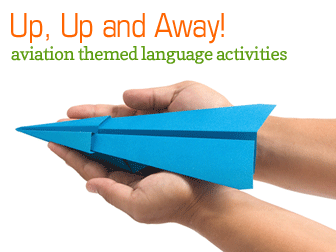Itís a Small World: Language Activities to Bring Together Nations


With this type of shared experience, your students will probably enjoy sharing a piece of their personal history with their classmates. Help your students tie their flight time memories into the everyday with these aviation themed activities.
Get Out of the Classroom
If you can, take your students to tour a local airport. Before taking your trip, ask your students to share in small groups any experience they remember from a time that they flew on a plane. They may share memories of the plan, visiting the cockpit, or waiting in the airport. Though international airports may be off limits due to security parameters, you may be able to bring your class to a county or private airport to give them a shared experience. Ask the manager of the airport if he would be willing to take your class on a tour of the facility. During the tour, encourage your students to ask questions of the manager and pilots they might encounter. In addition, challenge your students to take note of the layout of the airport. Once you return to class, ask your students to reproduce that airport layout on a large poster and use the vocabulary they have been learning to label each area. You can also ask your students to write a thank you note to your tour guide for his time and attention during the field trip. Follow up your field trip with a free writing experience in which your students compare their previous trips to the airport with the shared class trip.
Follow Directions
You can use an aviation moment to give your students some practice with following directions. Photocopy some pages out of a paper airplane instructional book or find some online and provide your students with some paper. Challenge each person to follow a set of directions to make a paper airplane. You can choose instructions that are as easy or as difficult for your students to follow as you like. The important thing is that they are reading the directions and following them to create their very own paper planes. Once your students have followed the directions and have their homemade planes, give your students some time to decorate and personalize their planes before having a contest. Take your students outside and line them all up with their airplanes for a distance challenge. On the word go, have everyone release his plane in the same direction. In a challenge to see whose plane can travel the farthest, award the winner with a ribbon, homemade trophy or other simple prize! You may want to have three flight trials and measure the total distance each plane travels awarding the person with the greatest overall distance travelled and the one with the longest single flight.
The History of Flight
If your class has internet access or can make use of a computer lab, let your students do some exploration on the history of flight with this on-line exhibition provided by the Library of Congress. This site presents a great deal of information on the history of flight. Divide your class into three groups to do the research. Each group should read the introduction, and then assign each of the groups to one area of the web site to research: the dream, the achievement, and the timeline of flight. Have each group read the information and make notes of the main points they find there. Give each group a chance to talk together and decide what information they will pass on to the rest of the class. Then divide your students into groups of three, one person from each of the original groups. In this new group, each student should explain to his partners the information he read in his section of the web site. If each explanation is adequate, each of your students will have gotten practice in both reading and speaking and will have access to all the information that the web site provided. Your students can then use this information to write their own reports on the history of aviation.
Video Planes
If you are looking to increase your students’ vocabulary and give them some listening practice in the bargain, try this set of videos from ehow.com. In the first video, Mike Camelin walks the viewer through the basic exterior parts of an airplane. Provide your students with a simple plane diagram available from the International Aviation Academy of Australia. Then play the short video for your class at least three times and challenge them to listen for the various parts of the plane listed below. As your students listen, they should try to label each of the parts on the plane diagram. Once you have given your class ample opportunities to watch the video, have small groups of students compare their answers before reviewing the diagram as a class.
Another video that Mike Camelin makes available on ehow.com is how to choose a good flight school. In this one-minute video, Camelin lists three qualities that someone should look for in a flight school (a structured syllabus, clean and well-maintained aircraft, and ample resources). Challenge your students to listen for these three necessary qualities and then to list either examples of those traits or reasons why they are important.
Mike Camelin also presents a video on how to turn an airplane. He describes two different motions that are necessary for a plane to turn. These are a tilt and a yawing motion. After watching this video, ask your students to describe what each of these motions is like first using their hands (as Cameline does in the video) and then without using their hands. You may want to have your students write these descriptions and then compare with a partner.
So take off into the wild blue yonder and explore the topside of the world with some of these memorable activities!